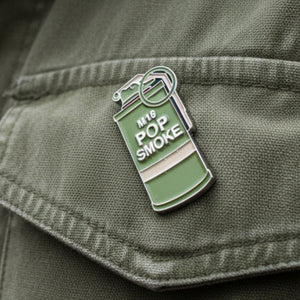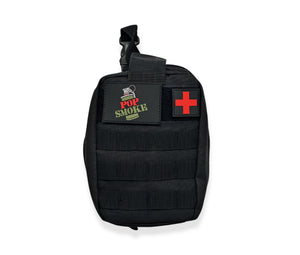Airman turned actor shares experience with military uniforms on Hollywood sets
When watching military movies, veterans constantly notice all kinds of slip ups with military attire. Nothing takes a vet out of a movie faster than seeing a poorly put together uniform. It makes one wonder, who is overseeing this wardrobe, and how did Hollywood think vets won’t notice?

Photo courtesy of Sienna Benton
We all thought it ironic that casting didn’t feel we looked “the right part” for the branch we actually served in, but that’s Hollywood for you.
Gear Spotlight: Relevant to This Story
 M18 Enamel Pin – For When It’s Time to Bounce$9.99 $4.99
M18 Enamel Pin – For When It’s Time to Bounce$9.99 $4.99 SICKNESS FOR THE THICCNESS TEE$29.99 $14.99
SICKNESS FOR THE THICCNESS TEE$29.99 $14.99
Being a veteran and an actor, I experienced this first hand. I’ve been cast in USO and USAA commercials, as well as played military background, and modeled for military themed advertisements. Before being cast in any of these projects, I had always imagined the person in charge of wardrobe had to have at least served themselves, or at least did research on the uniforms required for the project. The sad reality is that most of the time, the person assigned to wardrobe, never served a day in their life and likely doesn’t know where to find the regulations for military attire.
My experience in uniform on set
I was cast for a USO commercial. I got a call around midnight asking me to be on set by 0400. This was a shock considering usually you get at least a 24 hour advance notice, but in the entertainment industry, flexibility in your schedule is imperative. The location we were filming at was about an hour away, so I had a choice, either get three hours of sleep, or stay up.
When I arrived at o-dark thirty, it was literally a hurry up and wait situation. As I sat in a cold metal chair, wishing I had brought a blanket, an assistant asked me come to wardrobe for a fitting.
For those who are not familiar with the term, ‘fittings’ are when you try on the costume or outfit that you will wear on the day of the shoot. These are normally done at least 24-48 hours in advance. So to see I was getting my fitting the day of the shoot, is not necessarily abnormal, but also not advised, (especially if it’s a wardrobe for a character that should be historically accurate.)
I followed the assistant, who introduced me to the lead stylist. She handed me a Coast Guard uniform and asked me to try it on. Being that I served in the Air Force, I had some knowledge how how to wear a military uniform, but every branch has different rules and regulations, so I wasn’t quite sure I had measured my ranks and ribbons correctly.
When I tried on my wardrobe, I was disappointed to find it was substantially too big. I knew that if this was an active duty situation, this uniform would have been unacceptable. I kindly pointed out the oversized areas to the lead stylist, who had to sew, hem, and alter it immediately. It felt she was giving herself more work than what was needed. “Do you have a smaller size,” I asked. “This is the only one we have for you,” she replied.
I didn’t understand because my casting profile clearly has my height, shoe, shirt, pant, etc. sizes listed on my profile. Did the warehouse not have my size? Or did the stylist not read my sizes before picking the uniform up from the warehouse? I had to take a moment to contain my frustrations, because in this industry anything can go wrong and I did not know who was to blame for this mishap. All I could think about was all the potential viewers laughing at me because I looked completely out of regs.
As she proceeded to alter and fit other actor’s who showed up to set, I found they too were having issues with their uniforms. Fortunately, these other actors were also veterans from different branches, so I was not alone in being cast in a branch that I had never served in. We all thought it ironic that casting didn’t feel we looked “the right part” for the branch we actually served in, but that’s Hollywood for you.
As our uniforms came out one by one, we put them back on until we were all set ready. Mine unfortunately was still too big, but it was the best this clearly stressed stylist could do under the circumstances. We tried to hide my oversized pants with an oversized jacket. Clearly it didn’t work, because the only shot of me that made the commercial was a micro second of me on a boat in the far distance. Too far to tell if my uniform was out of regs.
Once we were all fitted, we rejoined in the waiting area for further instructions. We looked over each other and laughed as those who served in the Coast Guard, pointed out my ranks were in the wrong place. I laughed as I saw an Army vet wearing an Airman First Class Ranks, who had his sleeves rolled. Although technically you can roll your sleeves in the Air Force for hot weather, it is frowned upon unless you are an Officer. We all concluded that although our stylist did her best, she had no clue how to dress us.
There was even one veteran actor who had done this dance before, and came prepared with his military fix it kit. He brought scissors, polish, lint rollers, and even hair gel for the ladies. We looked each other over and even coordinated categories. Air Force vets fixed the Air Force actor’s uniforms, Marine Corps vets fixed the actors cast as Marines, so on and so forth. We cut cables, borrowed a lint rollers, measured rank placements, reorganized ribbons, and more. It was a unique bonding experience across all the military branches. It was great to slightly relive the days of “Check yourself before you wreck yourself.”
I am not saying that this experience is representational of every experience I’ve had on different sets. Some sets do have military tech advisors that hire a team of experts to check you over. However, that’s only for projects with deeper pockets than most. Otherwise, it is an unwritten rule, that if you happen to find yourself in an all veteran cast, the wardrobe is often corrected by the actors.

Photo courtesy of Sienna Benton
What about when the cast isn’t stacked with veterans…?
As for sets that are not an all veteran cast, that is a different story. This is because you do not have the support of the all veteran cast to look you over. If you are cast as a character in a branch you never served in, you are left to the mercy of the wardrobe stylist. By that point, you’ll have likely learned that wardrobe doesn’t always have the experience, time, (or in most cases) the budget, to fund that kind of research. Hollywood is looking to make just a good enough impression to appeal to an average viewer.
However, to veteran actors, we know how important it is to give the uniform it’s proper representation. Do you want veteran viewers to remember how good your acting is, or make fun of how out of regs you look? So once you have your fitting and your instincts tell you something is wrong with your uniform, you’ll likely have to look up the regulations, and correct it yourself.
Another thing we have to take into consideration as to why Hollywood gets the uniform wrong, is because the roles we see the most, are big budget shows and films that cast actor’s who never served in the military. The only people they have to rely on for accurate representation is the wardrobe stylist, and a military tech advisor (if the production can afford one). So slips ups are bound to happen. Maybe an actor will have an action scene, where a few members of the stunt crew served and can assist, but that is not always the case.
You might be thinking, why can’t production just hire real vets as wardrobe stylists? The answer is a few reasons. One being that there are not enough veterans interested in being wardrobe stylists, so it’s slim pickings. Another being that production doesn’t have the budget to hire a military tech advisor, or also wardrobe stylist’s simply don’t know where to search for this information.















